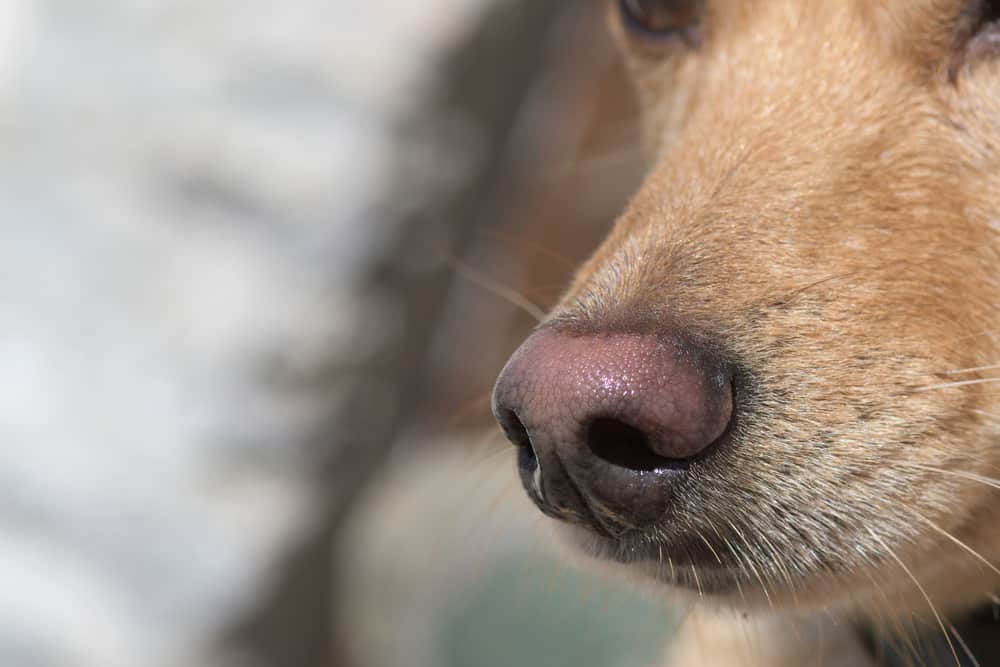Dogs have marvelous olfactory senses. Their sense of smell is far superior to ours. Humans have six million olfactory receptors, and dogs have a whopping three hundred million olfactory receptors. Dogs have an immense world of smell that we can’t even imagine. Tracing scents and tracking prey by smell is natural for them. We have learned to use their ability to help us hunt, find missing people and sniff out banned substances.
Start training your dog to scent by using strong-smelling food. This provides an immediate reward. You can use some essential oils such as birch, thyme, lavender, anise, and catnip. Scenting packs are sold, including scents for game birds, bobcats, rabbits, foxes, and other animals.
Dogs benefit from scent training. It is beneficial as mental stimulation for dogs, which is as important as physical exercise. Smelling and sniffing activate certain areas in the dog’s brain, which releases a neurochemical transmitter called dopamine. Dopamine makes dogs feel good, and so the act of tracking a scent is biologically rewarded by the dog’s own body.
Some Basic Rules For Scents To Use In Scent Training Your Dog
- When selecting scents to train your dog, it is best to stick to readily available ones. You may need to use the scent for an extended period while you are training your dog. If you suddenly run out and cannot source the scent, it could delay your dog’s training.
- The scents you choose to use should be unique in the area. If the smell exists naturally in the training area you are using; it will confuse your dog.
- Do not touch the object that you want the dog to find with any part of your skin. Your dog may begin trailing your scent, which will confuse the training.
What Are The Best Scents To Use In Beginner Scent Training?
The best scents to use when starting your dog off with scent training is strong-smelling food items. This includes most meats, but those with more pungent smells, such as bacon, are obviously easier to use. Entrails and organ meat (liver or kidneys) from animals are also quite potent smells. Although they may be unappealing to us, dogs love them.
The significant factor in using food is that the dog already knows these smells mean food. This motivates the dog to search for the food and then gives him an immediate reward when he finds it.
Can I Use Cheese When Scent Training My Dog?
Some people like to use smelly cheese to train their dogs. This can work very well, but it is important to note that some dogs cannot digest lactose. They will become very ill with diarrhea and possibly vomit.
Cheese is very high in fat and so is best used in moderation. Too much cheese can result in weight gain and a condition known as pancreatitis. Pancreatitis arises when the dog’s body cannot process fat, and the pancreas becomes inflamed.
How Do I Stop Using Food To Scent Train My Dog?
Initially, the food item can be used, but this needs to be phased out eventually. Instead of trailing the meat, rub a dummy, ball, or swab in the juices or fat of the meat. When the dog finds the object, he can be rewarded with a food item. This is a helpful transition in that the dog learns not to eat the target he finds.
Are There Any Essential Oils That Can Be Used To Scent Train A Dog?
Essential oils must always be used with care, as some of them can be toxic to dogs. The most commonly used one is birch oil. The American Kennel Club recommends the use of birch oil.
Other essential oils that can be utilized are:
- Catnip – Nepeta cataria
- Valerian
- Lavender
- Thyme
- Anise
Help – My Dog Won’t Trail An Essential Oil Scent
Dogs differ in their response to essential oils. Some enjoy the scents mentioned above, and some will not trail or be attracted to any essential oil scents. With these dogs, it may be better to use one of the alternative scents to train.
Some people have found their dogs will respond to certain herbs, but this is a hit-and-miss affair as not all dogs like the smell of herbs.
Essential oils are particularly potent smelling substances, and sometimes they are used by smugglers to mask the smell of contraband.

Some Other Scent Options For Training A Scent Dog
There are some other scent options for training scent dogs, but you may need a strong stomach to implement them.
- Livestock manure is wildly popular with dogs. You can use small pieces to make the trails or rub the dummy in the dung.
- Scents from other animals such as unknown dogs, cats, hamsters, etc., are appealing to dogs. You can rub the dummy or other object on these animals and use this as the scent for training.
- Dead or rotting animals or other substances attract dogs – – how many times have you come home from a walk with a dog that pongs badly because he rolled in something rotten? Some trainers go so far as to collect road-kill to use for training their dogs.
- Dead ducks, rabbits, or chickens are often used as these are usually readily available from hatcheries or farms. The smell of the dead bird or rabbit can be enhanced by soaking it in water.
- Freshly killed pigeons are used by some trainers. This scent is not for the soft-hearted or animal lovers. Some trainers breed pigeons to use when training hunting dogs.
- A study was completed and reported on in the Applied Animal Behavior Science Journal. The study showed that dogs would track vanilla, coconut, and ginger. They also noted that lavender and rabbits were popular scents in the dogs they studied.
- The Scentwork United Kingdom association recommends the use of cloves and truffle oil.
- Dogs will very happily scent out and track their owners and fellow pets. Scientists have shown that interactions with their owners and fellow pets, such as petting or playing, releases oxytocin. Oxytocin is the chemical that creates a feeling of happiness and love or affection.
Can You Buy Scents For Training Your Dog?
There are commercially produced scents for use when training your dog. These are in the form of liquids that can be sprayed or used to douse the swab, ball, or dummy to be found by the dog. Gun dog supply companies keep a range of different scents that can assist you with training your dog.
They include the following scents:
- Dove
- Duck
- Quail
- Grouse
- Pheasant
- Rabbit
- Squirrel
- Coon
- Bobcat
- Fox
- Mountain lion
- Coyote
- Bear
- Wild boar
Scentwork UK also recommends the use of gun oil – specifically Napier Gun Oil.
What Can I Use to Do Scent Training Through Water?
Some companies make wax scents for use in training dogs. The most famous one is Dokken Dog Training Scent Wax. This wax comes in an easy-to-carry tube form (similar to Chapstick) which fits into a trainer’s pocket. It does not dry up quickly like liquid forms of scent and is waterproof.
The wax comes in various scents: Dove, waterfowl, pheasant, quail, and grouse. This product is handy for serious hunters that are completing field training with their dogs.
Conclusion
Food, especially meat, is an easy and rewarding scent item, to begin with when scent training your dog. Some trainers use essential oils and herbs, but this tends to be dog-specific, and not all dogs respond well to them. Dogs will track scents of new animals, droppings, anything rotten, and their owners.
Sniffing out scents is natural to dogs. They enjoy the activity, and it provides an ideal bonding exercise for dogs and owners. Scent training as a mental exercise helps use energy in dogs with high energy levels. These dogs could become problem dogs if left to their own devices, and scent tracking is an ideal solution.

